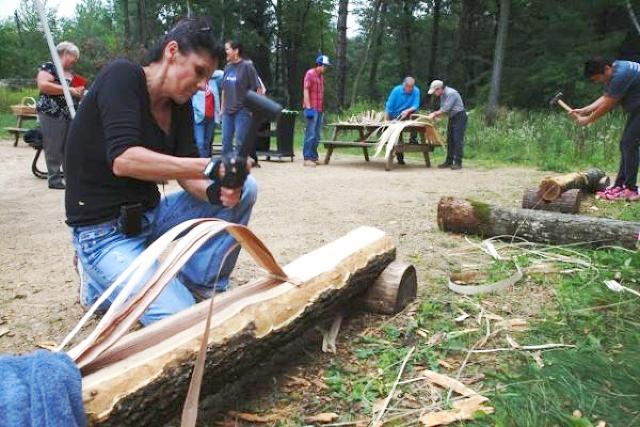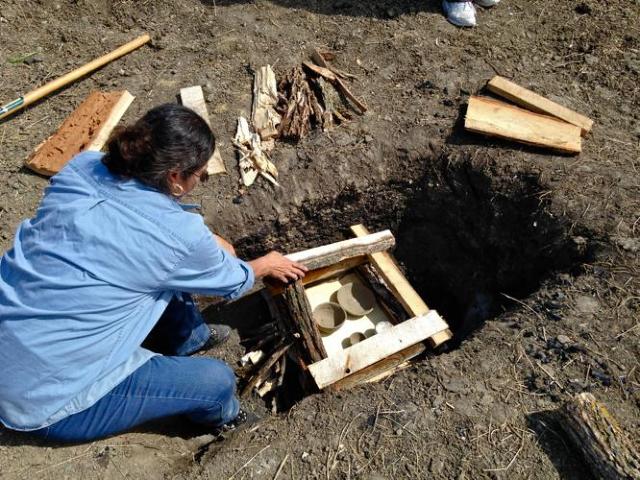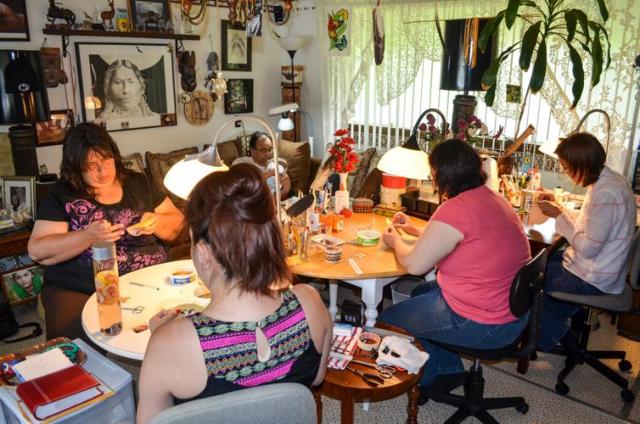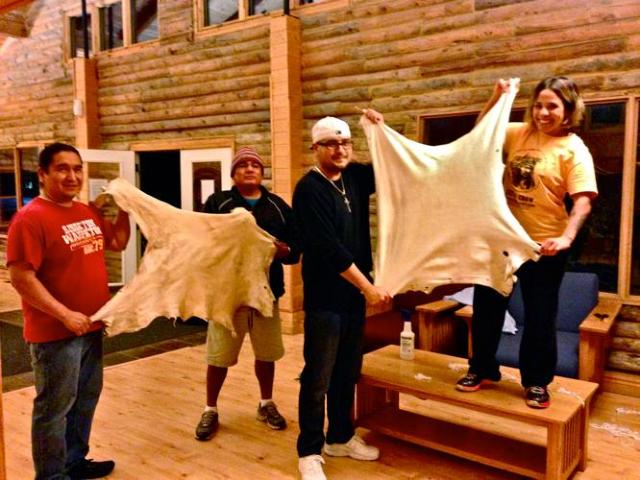 |
Canku Ota
|
 |
|
(Many Paths)
|
||
|
An Online Newsletter
Celebrating Native America
|
||
|
December 2015 - Volume
13 Number 12
|
||
|
|
||
|
Rare, Traditional
Arts Making A Comeback At Tribal Colleges
|
||
|
by Christina Rose -
Indian Country Today Media Network
|
||
|
Ancient Native arts and technology are bringing a cultural revolution to 13 tribal colleges and universities that received a grant from the American Indian College Fund. The three-year "Restoration and Preservation of Traditional Native Art Forms and Knowledge Grant" allows tribal colleges and universities (or TCUs) to develop curriculum on lost or rare art forms that have fallen out of usage.
"It's art now, but back then, they were items for everyday living and use. Birch bark and porcupine quills; we are treasuring the gifts the land gives," Ronald Turney, Ojibwe, Leech Lake Tribal College multimedia specialist, said about collecting materials for the projects. "Everyone had a canoe, everyone always had baskets, there was always someone tanning hides. The rarity (of creating these traditional objects) has transformed into art now, and we are planning on bringing these things back."
Four TCUs—Leech Lake Tribal College (Cass Lake, MN), Oglala Lakota College (Kyle, SD), Sinte Gleska University (Mission, SD) and Turtle Mountain Community College (Belcourt, ND)—will be able to expand their existing arts programs by including traditional arts into the curriculum. Bridget Skenadore, Native Arts and Culture Project Coordinator at the American Indian College Fund, said each college will determine which arts to pursue. "What is endangered in Minnesota could be thriving in North Dakota, so it is up to them to decide which are their endangered or lost art forms," she said. Nine other TCUs have already received a quarterly grant, now issued every four months, for the development of new academic classes and community extension activities in the Traditional Native Arts, and other colleges can still apply. Through the grant, experts, often elders, will teach classes and train apprentices so the college can continue to offer the class after the grant expires. Skenadore said another component of the program is to support the livelihood of the artists. "Sisseton Wahpeton College in South Dakota has a master artisan who gives feedback about how and what has been taught, and sharing knowledge before setting up the curriculum," Skenadore said. "We want to focus on the intergenerational learning that is going on between the master artists and the community members and students. In the snowshoe class at the College of the Menominee Nation, the youngest participant was 7 years old and the oldest was 60 years old. All of the participants were sitting together at the table and teaching each other." When Dakota Studies Instructor Erin Griffin, Dakota, Sisseton Wahpeton College, first started teaching, she asked her students if Dakota people made pottery and they all said no. "So I showed pictures of pottery the people made long ago, and none of them knew about that. When we started doing the workshops, people were asking us where we ordered the clay from and we didn't," Griffin laughed. "We dug it from behind the building here."
Sisseton Wahpeton College is also developing a class for bow making and tanning hides, and according to Griffin, students and community members jumped at the chance to take the classes. This has been true with all the tribal colleges. "I have had people call me up in a panic thinking they aren't going to get in. I was surprised at how fast the pottery class filled up, and then the quillwork class filled even faster, and then the bow making class filled in two hours. I think that really speaks to the desire in the community," she said. Turney, at Leech Lake Tribal College, believes the classes fill so quickly because of the rarity of the art forms. "Not many people around here know how to do quillwork," he said. "Basically it was one older guy, Melvin Losh, whose pieces are in the Minnesota Historical Society Museum and the Smithsonian in Washington, D.C. He has been doing it for about 50 years now." Before the classes, only one or two canoes were made each year and there were only two people who made them, Turney said.
These art classes at Leech Lake are part of the development of a two-year associate's degree program or an accredited certificate in Language, History and the Arts. "We are also in talks with Bemidji State University so people can go to school here for two years and then go on there for a four-year degree," Turney said. At the College of Menominee Nation, the projects revolved around the arts, but Jennifer Gauthier, Menominee, who is the community natural resource economic development educator, University of Wisconsin office, Menominee College campus, said there were side benefits. "We ended up developing community groups and leadership. We also introduced the language tied to every art, which provided an educational component. Instead of just teaching basket making we tied it to the study of traditional Menominee materials, culture—showing how it is rooted in history and showing contemporary applications as well—and focusing on language, too."
The first project the Menominee college tackled was making birch bark baskets. "We wanted to develop an appreciation for the hard work that our relatives put into that. We went into tree identification, time of year to process those trees, what size tree to harvest and how to make their own strips, how to clean them, how to dye them, everything you can imagine; how to make a basket from beginning to end. From that first project and every project since then we have tried to tie in the same kind of process," Gauthier said. "We are doing more active use of the language rather than standing in front of the class and teaching them words. This is active, intentional learning." Like the other schools, the Menominee classes fill up almost immediately. "Within the workshops, we had a lot of intergenerational activities, and every workshop has incorporated a family working together and learning," Renee Okimosh, the project coordinator for the Menominee College workshops, said. "The class fills up almost immediately. They are really into it. There is a hunger to learn more within the community. To see the kids working with the elders, it's a way for these groups to get together and laugh, share stories, that sort of thing. That's really important stuff," Brian Kowalkowski, dean of Continuing Education at Menominee College, said. |
||||||||||||
|
|
||
|
|
||
| Canku Ota is a free Newsletter celebrating Native America, its traditions and accomplishments . We do not provide subscriber or visitor names to anyone. Some articles presented in Canku Ota may contain copyright material. We have received appropriate permissions for republishing any articles. Material appearing here is distributed without profit or monetary gain to those who have expressed an interest. This is in accordance with Title 17 U.S.C. Section 107. | ||
|
Canku Ota is a copyright ©
2000 - 2015 of Vicki Williams Barry and Paul Barry.
|
||
 |
 |
|
|
The "Canku
Ota - A Newsletter Celebrating Native America" web site and
its design is the
|
||
|
Copyright ©
1999 - 2015 of Paul C. Barry.
|
||
|
All Rights Reserved.
|
||





